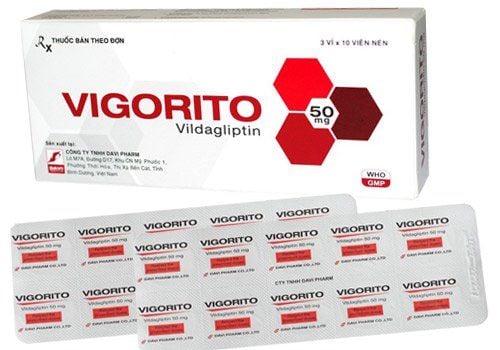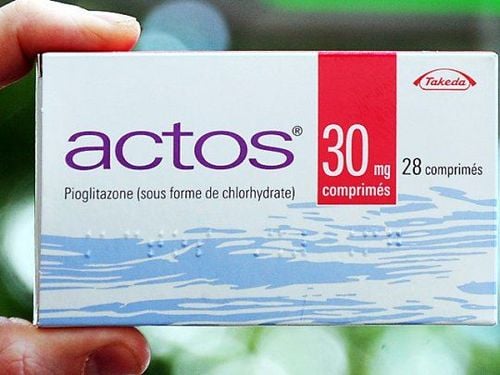This is an automatically translated article.
Agludril is made in the form of tablets with the main ingredient in each tablet is Glimeplrid granule 170.0mg, corresponding to Glimepirid 2.0mg. So what is Agludril and how does it work?
1. What are the effects of Agludril?
Gllmepiride is an oral sulfonamide, it has hypoglycemic effect, belongs to the group of Sulfonylureas. The main effect of Glimepiride is to stimulate the beta cells of the islets of Langerhans in the pancreas to release insulin.
Glimepiride's mechanism of action is that it binds to beta-cell membrane receptors, closing ATP-dependent potassium channels. Closing of potassium channels causes membrane depolarization, leading to opening of calcium channels, allowing increased calcium ions to penetrate into the cell. Increasing the concentration of calcium ions in the beta cells stimulates the release of insulin from the cells.
In addition, Giimeplrid also has an external effect, it helps to improve the sensitivity of peripheral tissues to insulin, and at the same time reduces the absorption of insulin in the liver. Glimeplrid increases the number of glucose transporters across the membranes of muscle and adipocytes very rapidly, increasing glucose uptake into muscle and adipose tissues.
Glimeplrid's hydroxy metabolite also has a mild hypoglycaemic effect, but it contributes only a small part to the total hypoglycemic effect of the drug. Glimepiride has a synergistic effect with Metformin or with insulin.
Agludril is indicated in the following cases:
Non-insulin dependent diabetes mellitus (type 2 diabetes mellitus) in adults. Agludril can be used in combination with Metformin or Glitazone or insulin. Agludril is contraindicated in the following cases:
Insulin-dependent diabetes mellitus (type 1 diabetes mellitus). Diabetic ketoacidosis. Pre-coma or coma due to diabetes. Diabetic hyperosmolar coma and acute diabetes-related illness requiring insulin. People with severe kidney failure, severe liver failure. Women who are pregnant or want to become pregnant. Women who are breast-feeding, if taking Agludril, need to stop breast-feeding. Hypersensitivity to Glimepiride or to any of the ingredients in Agludril. People who have ever been allergic to sulfonamides. Some notes when using Agludril:
Patients still have to follow a reasonable diet and exercise when using the drug. Agludril may cause hypoglycaemia, especially in patients with poor nutrition, adrenal insufficiency, pituitary, hepatic and renal failure who are prone to hypoglycemia. Patients who are stable on agludril regimen may still become uncontrollable under stress, trauma, infection, high fever, or surgery. At that time, insulin should be used in combination with Agludril or insulin alone instead of Agludril. 4 Using Agludril as well as taking other oral hypoglycemic agents, although blood sugar has been controlled, after a while, it may still not be able to control blood sugar anymore. At that time, it is necessary to increase the dose of the drug or combine it with other drugs such as Metformin, Giitazon or with insulin. When taking Agludril, blood sugar levels can be unstable, especially when starting use, changing therapy or using the drug irregularly, making the patient's flexibility, response may decrease. Special attention should be paid to hypoglycemia in the elderly, who are taking beta-blockers or sympathomimetic drugs, because symptoms are difficult to detect. It is necessary to periodically check blood glucose levels and measure HbA1c every 3-6 months, if necessary, appropriate treatment regimen can be changed.
2. Dosage and administration of Agludril
The drug Agludril is taken orally. Take the medicine once a day, before or during the first meal of the day. You need to swallow the tablet whole with about half a glass of water, do not chew or crush the tablet.
Dosage of Agludril should be according to the instructions of the doctor. The usual dose of the drug is as follows.
Initial dose 1 -2mg, once a day. The maintenance dose is from 1 to 4 mg, once a day. Adjust dose according to individual patient response, may increase dose after 1-2 weeks of treatment and not to exceed 2mg at a time. Maximum dose is 8mg/time/day. An overdose of Agludril leads to hypoglycemia. Symptoms of this condition include: Fatigue, tremors, extreme hunger, sweating, cold and damp skin, headache, anxiety, rapid heart rate, increased blood pressure, chest tightness, nervousness, irritability restlessness, arrhythmia, nausea, vomiting, drowsiness, decreased concentration/flexibility/reactivity, sensory/speech/visual disturbances, mild paralysis, dizziness, somnolence, confusion, depression , losing consciousness, leading to coma. When comatose, the patient will have shallow breathing, slow heart rate.
The clinical presentation of severe hypoglycemia can resemble a stroke. It may take up to 24 hours after taking the medicine for symptoms to appear.
Treatment: When you have the above symptoms, you need to immediately notify your doctor and go to the nearest medical facility for timely treatment.
Mild cases: Let the patient drink glucose or white sugar 20-30g mixed in a glass of water, then monitor blood glucose. Drink sugar water every 15 minutes, until blood glucose returns to normal limits. Severe cases: The patient is comatose or unable to drink, it is necessary to immediately inject 50ml of 50% glucose solution into a vein. Thereafter, a slow intravenous infusion of 10-20% glucose solution is given to gradually raise the blood glucose to the normal range. It is necessary to continuously monitor the blood glucose index for up to 24-48 hours, because it is easy to have recurrent hypoglycemia. If it is too severe, glucagon 1mg can be used subcutaneously or intramuscularly. If the patient takes too much Agludril, gastric lavage and activated charcoal should be given.
3. Side effects of the drug Agludril
The most important side effect is hypoglycaemia described in the section on drug overdose.
Common side effects of Agludril include:
Dizziness, dizziness; Headache; Nausea, vomiting; A feeling of fullness in the epigastrium; Stomachache ; Diarrhea; Temporary visual disturbance at the start of the drug, due to a change in blood glucose levels. Less common side effects of Agludril include:
Allergic or pseudo-allergic reactions; Redness; Medal; Itchy. Rare side effects of Agludril include:
Increased liver enzymes; Jaundice; Decreased liver function ; Mild or severe thrombocytopenia; Hemolytic anemia; Decreased red blood cells; Leukopenia; Agranulocytosis; Allergic vasculitis ; Sensitive to light. Usually, the side effects of Agludril above will gradually decrease and go away on their own during treatment. But if symptoms become too severe, Agludril must be discontinued. Inform your doctor about the side effects you experience when using Agludril for timely treatment.
4. Interactions of Agludril with other drugs
Drugs that increase the hypoglycemic effect of Agludril when used together such as: Insulin, other drugs that lower blood sugar, Chloramphenicol, Coumarin derivatives, Ifosfamide, Cyclophosphamide, Disopyramid, MAO inhibitors, anticoagulants non-steroidal anti-inflammatory drugs, Miconazole, Probenecld, Quinolones, beta-blockers, sulfonamides, ACE inhibitors, anabolic steroids and male sex hormones. When one of these drugs is combined with Agludril, there can be a very dangerous risk of hypoglycemia. At that time, it is necessary to adjust and reduce the dose of Agludril. Drugs that increase blood sugar when combined with Agludril such as: Diuretics, Diazoxid, Corticosteroids, Catecholamines and other sympathomimetic drugs, nicotinic acid (in high doses), Glucagon, Estrogen, Phenytoin, Phenothiazines, thyroid hormone, Rifampicin. When one of the above drugs is combined with Agludril, it can lead to hyperglycemia, which can no longer control blood sugar. At that time, it is necessary to increase the dose of Agludril. The article has provided information about the uses, dosage and precautions when using Agludril. To ensure safety for your health and maximize the effectiveness of your treatment, you need to take Agludril exactly as directed by your doctor.
Please dial HOTLINE for more information or register for an appointment HERE. Download MyVinmec app to make appointments faster and to manage your bookings easily.













